
Coalville is an industrial town in the district of North West Leicestershire, Leicestershire in the East Midlands of England, with a population at the 2011 census of 34,575. It lies on the A511 trunk road between Leicester and Burton upon Trent, close to junction 22 of the M1 motorway where the A511 meets the A50 between Ashby-de-la-Zouch and Leicester. It borders the upland area of Charnwood Forest to the east of the town.

The First Baptist Church is one of six National Historic Landmarks in Columbus, Indiana. It was designed by distinguished architect Harry Weese; construction was completed in 1965. Since completion, few alterations have been made and the building has retained its integrity. It was one of the first church designs to integrate Modern movement architecture and a non-traditional church plan.

The Martin Luther King Jr. National Historical Park covers about 35 acres (0.14 km2) and includes several sites in Atlanta, Georgia related to the life and work of civil rights leader Martin Luther King Jr. Within the park is his boyhood home, and Ebenezer Baptist Church — the church where King was baptized and both he and his father, Martin Luther King Sr., were pastors — as well as, the grave site of King, Jr., and his wife, civil rights activist Coretta Scott King.

The 16th Street Baptist Church is a Baptist church in Birmingham, Alabama, United States. In 1963, the church was bombed by Ku Klux Klan members. The bombing killed four young girls in the midst of the Civil Rights Movement. The church is still in operation and is a central landmark in the Birmingham Civil Rights District. It was designated as a National Historic Landmark in 2006. Since 2008, it has also been on the UNESCO list of tentative World Heritage Sites.
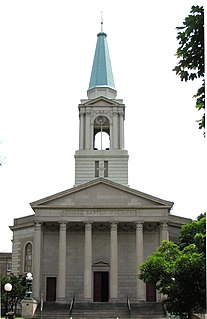
First Baptist Church is a historic church located in Knoxville, Tennessee. It is on the National Register of Historic Places.
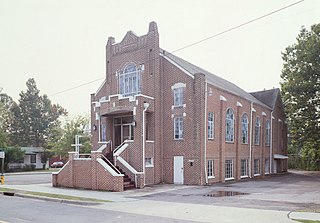
Bethel Baptist Church is a Baptist church in the Collegeville neighborhood of Birmingham, Alabama. The church served as headquarters from 1956 to 1961 for the Alabama Christian Movement for Human Rights (ACMHR), which was led by Fred Shuttlesworth and active in the Birmingham during the Civil Rights Movement. The ACMHR focused on legal and nonviolent direct action against segregated accommodations, transportation, schools and employment discrimination. It played a crucial role in the 1961 Freedom Ride that resulted in federal enforcement of U.S. Supreme Court and Interstate Commerce Commission rulings to desegregate public transportation.

The First Free Will Baptist Church are a historic Free Will Baptist Church complex in Ashland, New Hampshire. The complex consists of three buildings: the brick church building, which was built in 1834; the old vestry, a brick building standing near the street which was built c. 1835 as a school and converted to a vestry in 1878; and the new vestry, a wooden structure added in 1899 to join the two brick buildings together. The church, a fine vernacular Federal style building when it was built, had its interior extensively restyled in the late 19th and early 20th centuries. The complex was listed on the National Register of Historic Places in 1983, primarily as a good example of modest Victorian church architecture. It now houses the Ashland Community Church.

Springfield Baptist Church in Augusta, Georgia was built in 1801 and is a significant historical building for its architecture, religious history, and African American heritage. The congregation initially had a wood structure built and used by the Saint John Methodist Church. Since 1944, this building has been home to the Springfield Baptist congregation.
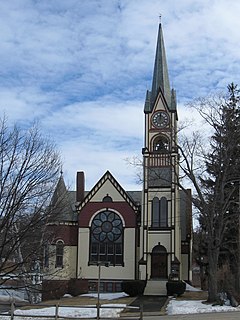
United Baptist Church of Lakeport is a historic church at 35 Park Street in the village of Lakeport in Laconia, New Hampshire, United States. Built in 1891 after a fire destroyed an older church, it is an eclectic local example of Late Victorian architecture. It was listed on the National Register of Historic Places in 1985.

First Baptist Church is located in central Davenport, Iowa, United States. It was listed on the National Register of Historic Places in 1983 as Calvary Baptist Church/First Baptist Church. It is affiliated with American Baptist Churches USA.

Christ Temple AME Zion Church, also known as Belmont Annex Fellowship Hall, is a historic African-American church at 235 E. Meeting Street in Dandridge, Tennessee.

The First Congregational Church, also known as Iglesia Pentecostes Evangelica Principe de Paz, is a house of worship located in Sioux City, Iowa, United States. An architectural rarity, it is one of a small group of churches in the Prairie School style of architecture. Designed primarily in the Prairie style with some eclectic touches by architect William L. Steele, its horizontal lines are emphasized by Roman brick and crisp rectilinear forms. Somewhat at variance are the distinctive dome and the prominent round heads on the windows.

The Church Hill North Historic District is a historic district in Richmond, Virginia, that was listed on the National Register of Historic Places in 1997. An expansion of the district was listed in 2000. This added 37 acres (15 ha) to the original 70 acres (28 ha)

First Baptist Church Of Wetumpka is a Southern Baptist church complex at 205 West Bridge Street in Wetumpka, Alabama that. It consisted of several connected buildings, centered on an original brick sanctuary building that was built from 1846 to 1852. The original sanctuary was slated for demolition by May 2020 following tornado damage. The grounds also include 1928–29 educational building, a 1959–60 second educational and office addition, a modern sanctuary built in 1967, and educational wing and fellowship hall that was completed in 1991. All of the buildings are centered on the original sanctuary and are linked together by a series of passages and corridors at the rear of the property. The original sanctuary was added to the Alabama Register of Landmarks and Heritage in 1977 and the National Register of Historic Places in 2008.
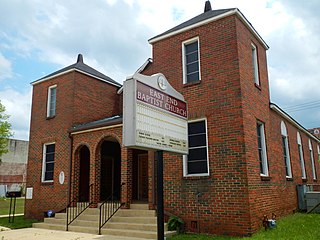
East End Baptist Church is a historic Baptist church building at 2609 Sixth Avenue South in Birmingham, Alabama. It was built in 1947 in a style that can be described as Romanesque Revival, but has been well described by Jay Price as mid-century traditional. It added to the National Register of Historic Places in 2005. During the Civil Rights Movement it was led by the Reverend Calvin W. Woods.
Mount Ararat Baptist Church is a historic church at 1920 Slayden Avenue, Ensley in Birmingham, Alabama. It is located in the Ensley suburb, west of downtown Birmingham, and overlooks Highway 239. It was originally built in 1929 but was modified in 1950 to add a red brick veneer.
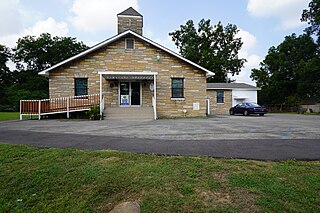
Shady Grove Baptist Church is a historic church at 3444 31st Way North, Collegeville in Birmingham, Alabama. The building is of concrete construction that was built in 1942 under the direct of its pastor, the Rev. Lewis J. Rogers. The exterior was faced with Permastone in the early 1960s. It is significant for its congregation's participation in the Alabama Christian Movement for Human Rights rallies for Civil rights in the 1950s and the 1960s under Rogers' direction. The building was added to the National Register of Historic Places in 2005.

Canaan Baptist Church is a historic church at 824 Fifteenth Street North in Bessemer, Alabama. Built in 1961, it had a congregation active in the Civil Rights Movement of the 20th century and was added to the National Register of Historic Places in 2005.
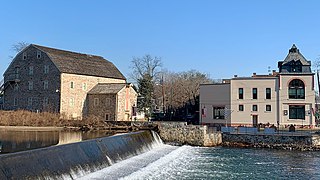
The Clinton Historic District is a 175-acre (71 ha) historic district encompassing much of the town of Clinton in Hunterdon County, New Jersey. It was added to the National Register of Historic Places on September 28, 1995, for its significance in architecture, commerce, engineering, industry and exploration/settlement. The district includes 270 contributing buildings, one contributing structure, and three contributing sites. Five were previously listed on the NRHP individually: Dunham's Mill, M. C. Mulligan & Sons Quarry, Music Hall, Old Grandin Library, and Red Mill.






















